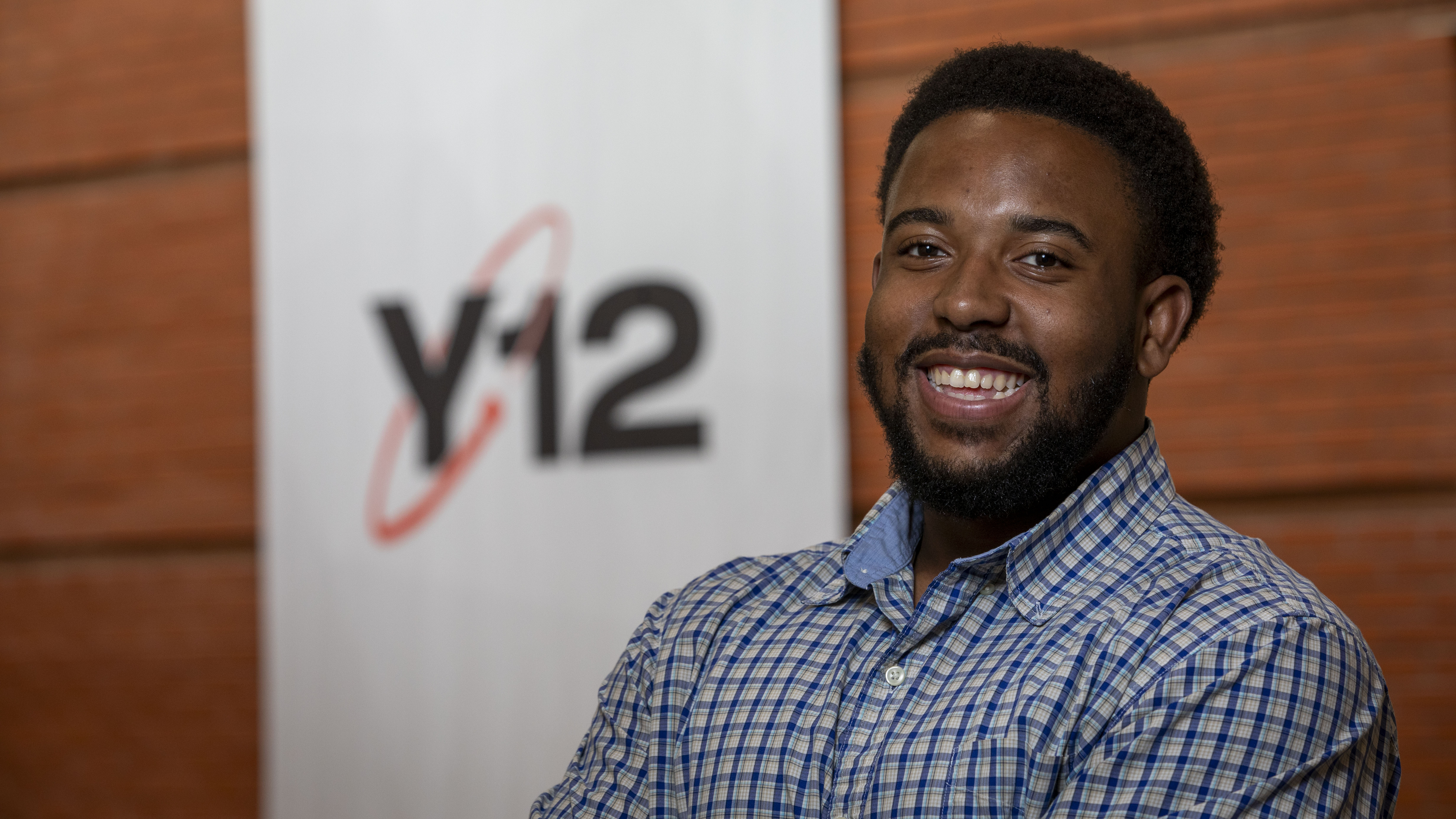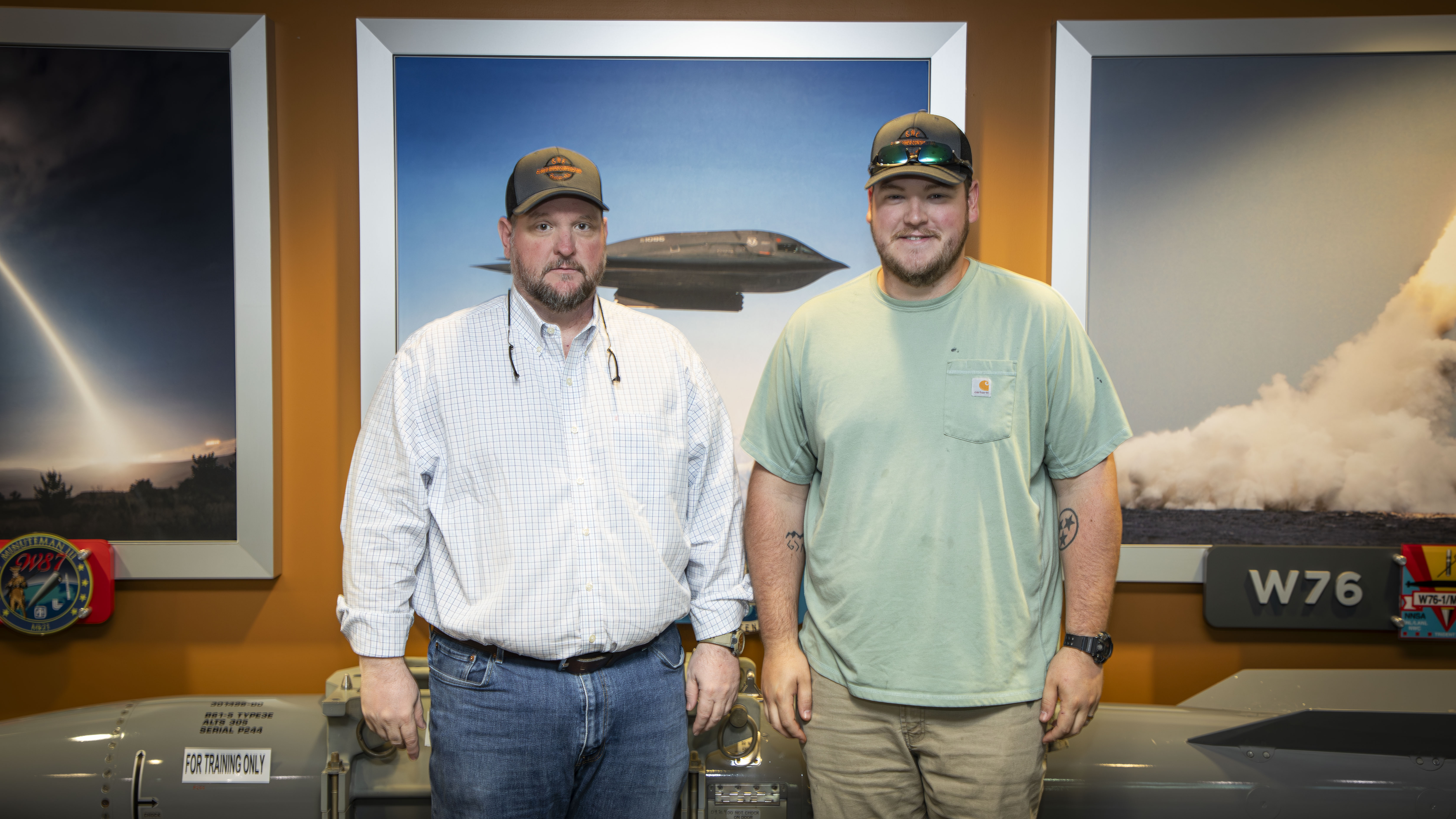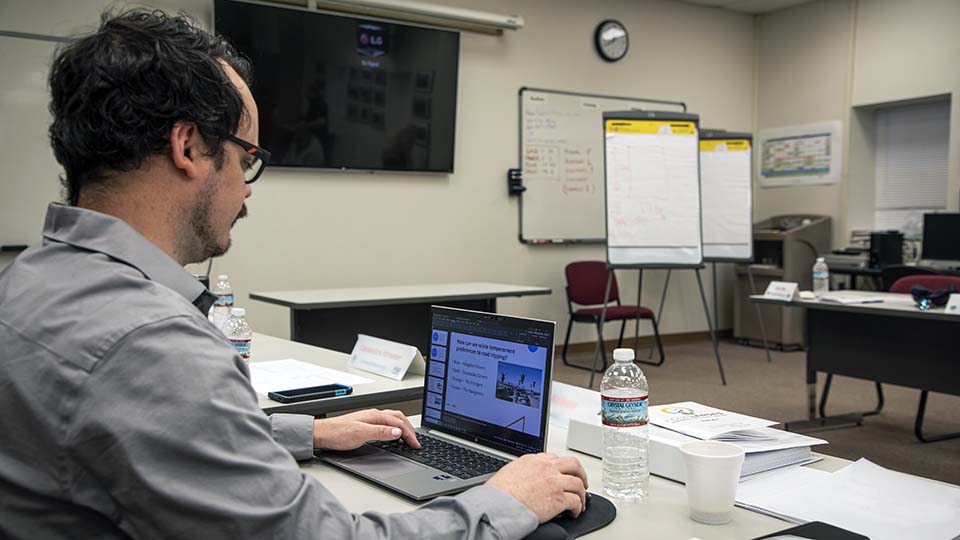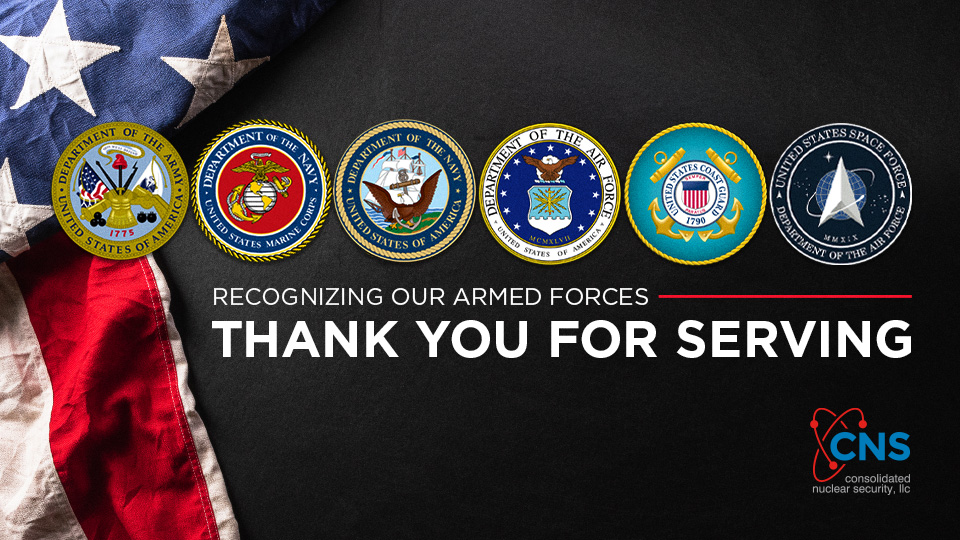Y-12 Blog

Y‑12’s innovative and safer low temperature method for yielding lithium has the potential to change current methodologies.
Lithium (Li) has been a valued commodity to the battery manufacturing industry since the 1970s, but the Y‑12 National Security Complex (Y‑12) has valued lithium for the nuclear deterrence mission for decades longer. Unfortunately, the standard process to make lithium metal is energy demanding, environmentally harmful, and dangerous for personnel.
One Y‑12 inventor is trying to change that. John F., a senior chemistry specialist in Y‑12 Development, created and patented a safer low-temperature and chlorine‑free approach to lithium metal production that yields higher purity, efficiency, safety, and performance. John F. also serves as the Principal Investigator on a high‑temperature cell project at Y‑12.
Conventional lithium metal production methodologies require lithium ore to be processed into lithium chloride (LiCl). This extensive and energy-intensive process requires electrolysis at extremely high temperatures (over 800 degrees Fahrenheit) to extract lithium from a molten salt, resulting in high energy demand and the release of harmful toxins such as chlorine which harm the environment. Applying his experience with battery science, extractive metallurgy, and knowledge of nuclear fuel solvent extraction, Freiderich built a lithium metal production process that is much safer and environmentally friendly.
The new method is conducted at near room temperature with a byproduct of oxygen. This method can yield lithium with purity above 95% by weight, resulting in improved efficiency, performance, safety, sustainability, and 92% less energy demand compared to high‑temperature cell methods, with the possibility to go directly from ore or raw lithium to metal. This new process could drastically reduce the environmental impact by removing caustic leaching steps with their accompanying energy requirements and molten salt bath.
“This technology has the possibility to eliminate the industrial process of roasting lithium-contained ores, like spodumene, which is a 900 °C process to produce lithium materials,” reveals John F. “While not fully explored yet, this technology also could potentially reduce the overall number of steps required by Y‑12 and the lithium industry to process Li materials.”
“The Plant Directed Research, Development, and Demonstration (PDRD) program has the unique capability to explore high‑risk and novel methods to modernize and improve our production plants,” states Mike E., Y‑12 PDRD Program Manager. “The low‑temperature, chlorine‑free lithium production method perfectly fits that mission space and has the potential to transform Y‑12’s current lithium manufacturing process.”
Y‑12 is partnering with Novae Metals through FedTech’s Emerging Tech Studio to commercialize the technology. With the commendation of the need to create a U.S.‑based supply chain for lithium and the exponential demand growth for the commodity by 2030, this new method is a potential game changer for Y‑12, the future of lithium battery production, and global energy.
“If successful, this technology can increase the purity of lithium metal with a smaller footprint, enhance worker safety, and minimize impact to the environment,” said Mike E. “Technologies such as this are what the originators of PDRD had in mind when first legislating this funding source to improve our production facilities, and it is exciting to enable the possibilities this process could bring.”

Jovon H. interned at Y-12 in the summer of 2023 and is now working in Y-12 Infrastructure.
Pantex and Y-12 recently welcomed a total of 87 interns from 31 different colleges and universities across the nation. These interns will spend 10 weeks learning about the CNS sites and their missions. They will engage in intense training and learning from their host organizations, culminating in a final project that they will share at the Intern Expo on Tuesday, July 23.
Internships offer students a chance to apply abstract knowledge to form concrete experience. Because of the unique missions at Pantex and Y-12, internship experience gives these graduates an upper-hand in landing a full-time position at one of the sites. From the 2023 intern class, nearly 40% have become full-time employees, with more planning to seek a position at one of the sites after they graduate.
Jovon H. interned at Y-12 in the summer of 2023 and is now working in Y-12 Infrastructure.
“I really enjoyed my internship. I made countless amounts of memories that will be cherished and carried with me through my life,” said Jovon. “Having the luxury of surrounding yourself with people who care about your well-being and have similar missions, goals, and ambitions that further assist you in your career development is not something you find at every company.”
Jovon said that networking was a valuable skill he took from his internship. He truly applied the saying, “It’s not so much about what you know as it is who you know.”
“My internship helped me have the capacity and flexibility to build quality relationships with people,” he said. “If no one knows your name, passions, ambitions, and/or face, how can others assist or know what your ultimate goals and ambitions are as an employee?”
Another former intern, Darby L., who interned at Pantex in 2022 and received a job offer with Pantex Career One after graduation, said that as an Amarillo native, she grew up thinking it would be great to work at Pantex someday.
“Getting to come out to Pantex while I was still in school helped me determine if I wanted to continue working at Pantex as a full-time employee,” Darby said. “I enjoyed the friendly community of Pantex as well as the overall mission statement.”
According to Darby, one of the most important skills she learned from her internship that she still uses in her job now is the ability to communicate effectively.
“In my job, I am always meeting new people as well as learning new things,” she said. “I learned the importance of asking for help when needed as well as asking questions. I have applied the communication skills learned from my internship into my everyday tasks.”
To the incoming interns, Darby offered this advice to help them during their internship: “I’d recommend building connections with your employers and fellow interns.”
Jovon echoed the importance of connecting with other people during an internship.
“Communicate and collaborate with each other,” he said. “Coming in, everyone is on the same playing field and is relatable. Also, seek a mentor in your organization who you look up to, and don’t be afraid to fail or ask questions.”

Y-12 recently welcomed 49 summer interns from 23 different colleges and universities across the nation.

Y-12er father and son, Tim and Zach, love that they have a shared mission at work.
June is the month to celebrate the fathers in our lives. Some lucky employees have the privilege of working with their fathers on‑site.
Meet Y-12ers Tim and Zach H., father and son.
Tim, a project manager in Y-12 Projects, and Zach, an electrician in Y-12 Construction, know very well what it looks like to follow in their fathers’ footsteps. Tim’s father and grandfather both worked at Y-12, and just like Zach, Tim started his career at Y-12 as an electrician.
“It is really cool to be able to say you are part of four generations who have worked to serve the very important mission here at Y-12 and have helped secure our nation’s freedom,” Tim said.
While they don’t get to see each other at work often, Tim says he’s fortunate to have a front row seat to see Zach grow in his career, be able to provide him with advice, and share the perspective he’s gained throughout his time at Y-12.
“He has taught me the importance of providing for my family and that if you have a good work ethic, the reward will find you,” Zach said about his dad.
From professional to personal achievements, Tim shares that he is proud of seeing Zach grow into the man he has become.
“Zach makes me proud on so many levels,” Tim said. “He is a new father himself and is such a great dad. On a professional level, he is someone who can be counted on to deliver and is always willing to learn new things. I guess that is something that Y-12 and I have in common; we are both lucky to have Zach.”

Wireless technology has made its way to the Central Training Facility (CTF), creating a more efficient learning environment for security police officers.
Located about 8 miles west of Y‑12, CTF is a DOE‑certified and approved weapons qualification and training facility used to equip security personnel to protect national security assets, facilities, people, and government property.
“The CTF holds a variety of courses that range from entry‑level to tactical training disciplines,” said Jay W., CTF Range Operations manager.
Class sizes vary from 10 to 35 students, and courses are open to all DOE sites. The facility also holds site‑specific training and qualifications for more than 650 security police officers across three entities: Oak Ridge National Laboratory, Oak Ridge Protective Force, and Y‑12.
Trainees previously were unable to connect to the CNS network due to the lack of wired terminals. The installation of unclassified wireless access points now allows the classroom portion of the training to transition to online learning.
“Having wireless connectivity is a significant productivity gain for our facility where students previously had to share a single computer to access National Training Center coursework through a wired connection point,” Jay said. “Now, students are able to connect at any point using their laptops and cell phones.”
Collaboration among CTF, Information Solutions and Services, Safeguards and Security, and Operations Health brought project success earlier than expected.
“A WiFi signal at CTF was something we didn’t believe was possible a year ago,” said Joe R., Physical Security senior engineer. “Yet, we finished the entire process — from configuration and testing to installation — in 12 months.”
Now that the facility has the foundation to connect wirelessly, additional resources are being planned to further develop the facility and classroom training. For instance, a wireless‑enabled air‑quality monitoring system for the indoor range is being tested to fulfill an Occupational Safety and Health Administration requirement. Once operational, the system will allow range managers to observe and maintain environmental and occupational controls to protect personnel from the effects of lead, noise, or any other relevant exposures.
Training costs will also be significantly reduced over time as pages of lesson plans are moved to a web‑based platform. “Students without computers still have the option to have physical copies of the training manuals, but we’re looking forward to being able to go fully electronic,” Jay said.
To support a full‑time online training environment, the facility’s goal is to establish a wireless computer lab by Fiscal Year 2025 after evaluations and testing are complete. As of March, the CTF conducted a test bed with a basic instructor class of 16 personnel.
“Once finished, the computer lab will give us the option to completely eliminate the need to print training materials,” Jay said. “Based on current manuals at 750 pages for each student, we estimate that we’ll save approximately 26,250 pages per training class, plus have the availability to apply updates automatically without reprinting.”
Installing unclassified wireless at the CTF is a sign of progress, and Digital Transformation integrated product teams are continuing to make risk-informed decisions to enable wireless in other areas across the site while complying with technical security, cybersecurity, and NNSA requirements.
“Our end goal is to implement solutions that support access to business, security, and operations systems site‑wide through wireless technology,” said Mark P., Digital Transformation senior manager. “Right now, we are still in the process of determining requirements and maturing technical implementation plans to address any potential wireless vulnerabilities and ensure that we’re delivering the best product for our mission.”

.Celebrating Armed Forces Day
Being part of a military family has challenges and benefits unique to military service. Our servicemembers give up a lot of freedoms to protect our nation, but so do the families supporting them. These families are often unrecognized for their role in service to the nation. They often don’t have a choice regarding where they will live and work. The servicemember is deployed for months at a time, leaving the family behind to deal with the home front.
That longing for togetherness as well as concerns for safety are heightened when the servicemember is deployed to a combat environment.
“The most challenging part of being a military family is when the servicemember gets deployed to a remote location and communicating is very limited,” said Lisa H., information specialist in CNS Communications at Y‑12. “This is especially challenging when the remote location is in a war zone. When your family member is away, you try to keep busy with day‑to‑day challenges of life, but your mind is always on the one deployed.”
Those extended deployments can stress the family environment, but they also create opportunities.

Y‑12er Rose R. stands with her husband, Major Brennan R., at his promotion ceremony.
Rose R., Y‑12 administrative assistant for Nuclear Safety, describes her life as an adventure.
“Being a military family is different to lives as nonmilitary families, as expectations for your level of flexibility and resiliency are much higher than in regular civilian life,” Rose said. “We have moved 7 times in the past 14 years to places like Vicenza, Italy; Tunis, Tunisia; and my husband is currently stationed in Mali. It can be difficult to plant deep roots anywhere, but you have roots far and wide, across the U.S. or the world, wherever your posts may be.”
Like their active‑duty counterparts, many military families develop deep bonds with other families where they’re stationed.
“Your military friends and associates become your family members, especially when serving overseas,” Lisa said. “You are in a small, remote group with the same purpose. They are family you will always maintain contact with, just as you would your immediate family. If you need help, your ‘family’ will be the ones there to assist.”
The bond that military family members who work at Pantex and Y‑12 share also strengthens their sense of pride to be part of the sites’ missions, knowing the work they do directly affects their servicemembers’ lives.
As both seen and unseen sacrifices continue to be made daily for the protection of our nation, Pantexans and Y‑12ers would like to say “thank you” to all active servicemembers, veterans, and military families for all they give in service to this country.
